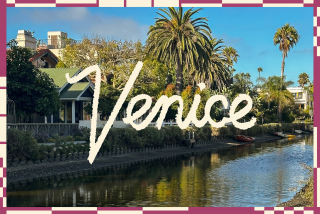Venice--An Elegant City That’s Alive and Well
- Share via
VENICE, Italy — Venice, I was sure, would be a sad song.
For years I had read of its dilemma: rising waters, sinking islands, threatened artworks.
“Death in Venice” was, in my preconceived certainty, more than a book title. It was the metaphor for the entire, forlorn, dying city. Or so I thought.
Glorious surprise, then, to find that Venice is alive and well, thank you, and thriving with a joy of living unlike any other city in Europe. Venice is no dirge; it’s a lusty, gusty love song from some of the happiest people in the world.
The word Venezia slips proudly, and often, from the lips of the residents. Venezia (Venice) is, in their view, not just the best place in the world to live, it’s the only place. Humdrum other Europeans, the Venetians say, must live their dreary lives on the mainland. But the people of Venice are true amphibians, never more than 100 feet from water.
Among 100 Islands
Purists would point out that the city of Venice extends to the mainland, 2 1/2 miles away by bridge. That drab, industrialized part of the city is nothing to write home about. But the real Venice, the historic Venice, is out there among the 100 islands. Cross the bridge, or better yet, take the water taxis to any of those islands, and suddenly one is in Oz on the Adriatic.
Hotels on the islands, like many other kinds of buildings, are deceptive on the outside. Fading facades and water-stained brickwork hint of bleak interiors. But no. Step off a water taxi, walk inside and be dazzled. Marble, silver, brass, copper, crystal. Many hotels on the islands do a star turn with their opulent interiors. Venetians still like to flash their love of luxury.
Venetians also love high fashion. Watch the rush hour traffic on the ferries to and from Piazza San Marco (St. Mark’s Square). Slim businesswomen, coiffed to the nines, are wearing 1940ish suits, carrying leather attache cases and reading avant-garde novels as the boats plow up the canals. Slim businessmen in rakishly cut silk suits likewise stand out elegantly amid the cattle-car push of tourists and Italian mainlanders on these seagoing “subways.”
Venice was a super-rich, super-powerful independent state hundreds of years before it joined Italy in the 19th Century. The power of old Venezia is long gone but the glory is still here, sinking into the sea at about a foot every 100 years.
A Treasure Trove
Nowhere is the glory more prominent than in St. Mark’s Square. And nowhere on earth have I seen such stately beauty so democratically enjoyed. People from all over the world, in all mode of dress and undress, stroll through this treasure trove of architecture.
They feed the pigeons. They listen to the cafe musicians, who, resplendent in tuxedos, play waltzes and evergreen show tunes. Wealthy, well-dressed patrons sit at cafe tables sipping their cappuccino. But anyone else can stand or sit on the marble plaza and listen, free.
Gawkers, in fact, are free to gawk most everywhere in this marvelous outdoor melting pot. No agitated managers or police warn “don’t touch,” “keep moving” or “pay a fee.”
Napoleon pronounced St. Mark’s Square to be “the drawing room of Europe,” and today all the other continents are represented in the daily gathering at this drawing room. Indeed, an enjoyable day can be spent here just in people watching, but the diversions are many.
St. Mark’s Basilica, its tile floor wrinkling with sinking foundations, is a gorgeous mix of Byzantine and Renaissance. Next door the Palace of the Doges is literally wall-to-wall art, fabulous art, but very chauvinistic art. Even many of the religious art scenes have a secondary theme about Venezia.
The Threatening Water
But why shouldn’t Venice brag? Where else on earth have bedraggled marsh islands been transformed into such magnificence? Where else are skylines so heroic, streets so beguiling and people so full of life?
Ah, the water threatens. Even St. Mark’s Square occasionally floods. “But that is when we put out the wooden sidewalks and walk over the water,” shrugs a tour guide.
I’m glad that engineers and art lovers are working to find a way to shore up Venice. I’m glad that there are those who weep about the dangers to the lovely old city; the tears surely result in attention to the problem.
But, yes, there is a Venice without tears. The gondolas still sweep majestically under the Rialto Bridge. The bell of St. Mark’s still makes lovers smile. The sunset over the Lido still outdoes a painting by Titian.
Venezia lives.
More to Read
Sign up for The Wild
We’ll help you find the best places to hike, bike and run, as well as the perfect silent spots for meditation and yoga.
You may occasionally receive promotional content from the Los Angeles Times.






